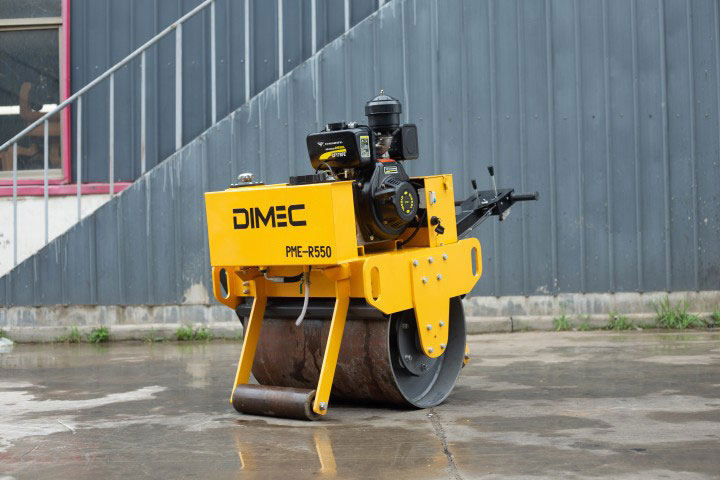What are the Key Differences Between Walk Behind Rollers and Ride-On Rollers?
- DIMEC
- Ride-On Roller, Walk Behind Roller
- 01/08/2024
Home » What are the Key Differences Between Walk Behind Rollers and Ride-On Rollers?

Table of Contents
Introduction
When it comes to construction, road rollers play a crucial role in ensuring a smooth and stable surface. Whether you’re working on a small driveway or a massive road project, choosing the right type of road roller can make all the difference. In this article, we’ll dive deep into the key differences between walk behind rollers and ride-on rollers. By the end, you’ll have a clear understanding of which type is best suited for your specific needs.
Understanding Walk Behind Rollers
Definition and Description
Walk behind rollers, as the name suggests, are compact machines that an operator walks behind to control. These rollers are typically used for smaller, more detailed work where precision is key.
Key Features
- Compact Size: Easy to maneuver in tight spaces.
- Manual Control: Operator walks behind, allowing for better precision.
- Versatility: Suitable for various small-scale projects.
Advantages
- Cost-Effective: Generally cheaper than ride-on rollers.
- Precision: Ideal for detailed work and smaller areas.
- Ease of Use: Simple to operate, requiring minimal training.
Common Uses
- Driveways and Sidewalks: Perfect for small-scale paving.
- Landscaping Projects: Useful for gardens and parks.
- Patch Work: Ideal for repairing small sections of roads.
Understanding Ride-On Rollers
Definition and Description
Ride-on rollers are larger machines that an operator drives. These rollers are designed for bigger projects and provide greater coverage and efficiency.
Key Features
- Larger Size: Covers more area quickly.
- Operator Cab: Provides comfort and protection for the operator.
- Higher Power: Suitable for heavy-duty tasks.
Advantages
- Efficiency: Covers large areas faster.
- Comfort: Operator sits in a cab, reducing fatigue.
- Power: Handles more demanding projects with ease.
Common Uses
- Road Construction: Ideal for paving large roads and highways.
- Large Parking Lots: Efficient for extensive surface areas.
- Industrial Projects: Suitable for heavy-duty tasks in industrial zones.
Key Differences Between Walk Behind and Ride-On Rollers
Size and Maneuverability
- Walk Behind Rollers: Smaller and more maneuverable, perfect for tight spaces and detailed work.
- Ride-On Rollers: Larger and less maneuverable, but more efficient for covering large areas.
Operator Position and Comfort
- Walk Behind Rollers: Operator walks behind, which can be tiring over long periods.
- Ride-On Rollers: Operator sits in a cab, providing better comfort and reducing fatigue.
Power and Performance
- Walk Behind Rollers: Less powerful, suitable for small-scale projects.
- Ride-On Rollers: More powerful, designed for large-scale and heavy-duty projects.
Cost and Maintenance
- Walk Behind Rollers: Generally cheaper to purchase and maintain.
- Ride-On Rollers: More expensive, but offer greater efficiency and power.
Applications and Suitability
Ideal Situations for Walk Behind Rollers
- Small Projects: Such as driveways, sidewalks, and landscaping.
- Precision Work: Where detailed and careful rolling is required.
- Tight Spaces: Where maneuverability is crucial.
Ideal Situations for Ride-On Rollers
- Large Projects: Such as road construction and large parking lots.
- Efficiency Needs: Where covering large areas quickly is important.
- Heavy-Duty Tasks: In industrial and extensive commercial projects.
Choosing the Right Roller for Your Project
Factors to Consider
- Project Size: Determine the scale of your project.
- Budget: Consider the cost of purchase and maintenance.
- Efficiency Needs: Assess how quickly the project needs to be completed.
Cost-Benefit Analysis
- Walk Behind Rollers: Lower upfront cost, but might take longer for large projects.
- Ride-On Rollers: Higher cost, but greater efficiency and performance.
Expert Recommendations
- Small to Medium Projects: Walk behind rollers are generally sufficient.
- Large Projects: Ride-on rollers are more suitable due to their efficiency and power.
Conclusion
Both walk behind rollers and ride-on rollers have their unique advantages and ideal applications. Understanding the key differences between them can help you make an informed decision for your construction project. Whether you need precision and maneuverability or power and efficiency, there’s a roller out there to meet your needs.
FAQs
What are the main uses of walk behind rollers?
Walk behind rollers are mainly used for small-scale projects such as driveways, sidewalks, landscaping, and patch work on roads. They are ideal for tasks that require precision and maneuverability in tight spaces.
How do ride-on rollers improve efficiency?
Ride-on rollers improve efficiency by covering larger areas more quickly than walk behind rollers. Their higher power and larger size make them suitable for extensive projects, reducing the time required to complete the work.
Are ride-on rollers more expensive to maintain?
Yes, ride-on rollers are generally more expensive to maintain due to their larger size, higher power, and more complex systems. However, their increased efficiency and capability can justify the higher maintenance costs for large-scale projects.
Can walk behind rollers be used for large projects?
While walk behind rollers can be used for large projects, they are not as efficient as ride-on rollers for such tasks. They are better suited for small to medium-sized projects where precision and maneuverability are more critical.
What factors should be considered when choosing a vibratory roller compactor?
When choosing a vibratory roller compactor, consider the size and scale of your project, your budget, the efficiency needs, and the type of work required. Additionally, think about the terrain and space where the roller will be used to ensure you select the most suitable option.
You May Also Like